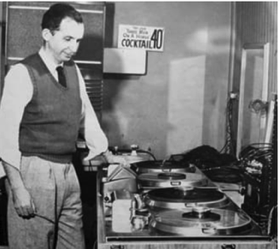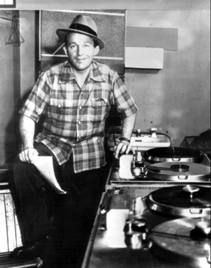LP: I'll tell you the story of how the tape recorder came to America. I was working with Bing Crosby on the Kraft Music Hall in California and Bing says to me: "You know, I wish there were a way I could do like you do. You have all your (transcription and wire recording equipment) at home, and you can record your stuff in your garage. I have to go down to the studio and do everything. I can't play on the golf course. I'd rather do it right at the clubhouse if I could. It just so happened that Judy Garland and I were doing a broadcast on Sundays in New York City. We had to fly from California to New York, and it took 19 hours. We were playing at 53rd and Broadway, and a little old man came up to me -- this was about 1945 or 46 -- and he said his name was Dick Ranger and he had a tape recording machine. He said he picked it up when we invaded Luxembourg in the big push to end the war. This was big news to me. Colonial Ranger said he walked into a radio station and saw this tape machine and grabbed it. It was too big to carry or ship back, so he dismantled it and brought it back to the States piece by piece. Colonel Ranger took this tape machine -- it was called a Magnetophon -- to Orange, New Jersey and put it back together. Then he made a copy of it he called the Rangertone. This was the first I heard of this technology and realized it was possibly just the machine Bing could be looking for. Unfortunately, Ranger could not supply enough devices in time to meet Bing's needs."
Luckily, another source of the German machine was brought back after the war by US Army Signals Corps Officer John T. "Jack" Mullin. Here is how it all began. The ashes of World War II were still smoking across the German countryside as Mullin, and his team carried out their mission. It was the summer of 1945, and they were searching near Frankfurt for a rumored Nazi weapon that used high-frequency sound beams to disable airplane engine ignition systems in mid-flight. The team inspected a strange, abandoned machine of some uninterpretable purpose, but never did find the weapon they were looking for. The journey wasn't pointless, however. It led Jack Mullin to his destiny.
Mullin was an engineer and a classical music enthusiast. During his service time in Europe, he'd frequently dialed in his radio to Nazi stations to marvel at the German music they played. If he didn't know better, he'd have sworn that the music was being played live, but not even Hitler was crazy enough to have orchestras playing 24 hours a day in the chaos of war. How then did the Nazis achieve such high sound quality with recorded music? The only technology Mullin was aware of couldn't come close to the clarity of what he was hearing.
During the failed search for the high-frequency antiaircraft weapon, Mullin ran into a British officer who gave him his first lead on how those marvelous German recordings were made. The answer was a device known as a "magnetophon," and the Allies had come into possession of some.
While just about every other soldier was pining to get back to the states, Mullin decided to postpone his return trip home. He went instead to the town of Bad Nauheim, Germany, to check out its radio station, which contained some of these magnetophons. He would later say it was the best decision he ever made. The quality of the magnetophons stunned Mullin. "It was one of the greatest thrills in my life," he said. "I will never forget that moment. I had never heard anything like it."
Mullin was not a man interested in fame or fortune. He was driven instead by his passion for machines and music. With that, he filed the necessary paperwork and took possession of two magnetophon high-fidelity recorders and 50 reels of Farben recording tape produced by the Allgemeine Elektricitäts-Gesellschaft company.
The machines had to be shipped back to the states in parts. One lost part could have ruined the whole operation. Luckily (and somewhat amazing considering the conditions of that time), all the parts arrived intact, and Mullin set about bringing the magnetophon to the United States.
He tinkered with the machines day and night, not only figuring out how they worked but also improving them. Once they met his standards of quality, he gave two public demonstrations in Hollywood in 1947. In each, he had a band play music live behind a curtain and then played the same music on a magnetophon - the audience couldn't tell the difference.
Finally, Mullin took it over to Ampex who took a look and said let's go with it. But first, they said, they had to have some money...so they went to Bing for the cash. He said how much do you want? They said $50,000. Bing wrote out a check for fifty grand with no interest. He said I don't want any part of the Ampex company. I don't want anything to do with you guys other than have you deliver me those machines. And so it was that Les worked on the very first broadcast with tape (Bing Crosby Philco Radio Time, 1947).
If one of the reels on that machine broke it could have killed five people in the room...it was going so fast. The tape that the Germans were using was made of paper. It was like fly paper. The Germans would just scratch some iron dust on it. Later 3M provided the first version of "Scotch" recording tape to replace that German paper stock. So that's how the tape machine got to America and Les's studio.
Jack Mullin and the new Ampex tape machines
Bing Crosby and the new Ampex tape machines


The German Magnetophon